As a devoted cat parent, you’re probably used to seeing your feline friend hack up the occasional hairball. But when it becomes a daily ritual, it’s time to investigate the cause of this unpleasant phenomenon. Hairballs are a natural byproduct of cats’ grooming habits, but they can be uncomfortable and even dangerous if left unchecked.
So why is your furry companion throwing up hairballs every day? The reasons can range from simple grooming issues to underlying medical conditions. By understanding the causes and symptoms of hairballs, you’ll be better equipped to prevent them from becoming a serious health concern for your beloved pet.
In this blog post, we’ll delve into everything you need to know about hairballs: what causes them, how to prevent them, and when it’s time to seek veterinary care.
Whether you’re a new cat parent or an experienced pro, you won’t want to miss out on these essential tips for keeping your kitty healthy and happy – without having to deal with daily hairball clean-up. So let’s dive in and discover the reasons behind your cat’s persistent hairball issue.
Causes of Frequent Hairball Vomiting
Feline hairball vomiting is a common issue that can be caused by a variety of factors. While occasional hairball expulsion is normal, daily occurrences may indicate an underlying problem. Here are some potential causes of frequent hairball vomiting and what you can do to help your furry friend.
Firstly, excessive grooming can lead to hairball formation. Cats groom themselves fastidiously, and when they do, they tend to ingest loose hair which can accumulate in their digestive system and form hairballs. If your cat is vomiting up hairballs daily, it could be due to excessive grooming.
Another possible cause of frequent hairball vomiting is a lack of fiber in your cat’s diet. Without enough fiber, their digestive system may not be able to process the hair they ingest during grooming, leading to hairball formation. Make sure your cat is eating a well-balanced diet that includes high-quality protein and fiber while avoiding feeding them too many fatty or processed foods.
Dehydration can also contribute to hairball formation and vomiting. If your cat is not drinking enough water, their digestive system may not be able to move the hair through their system properly, leading to hairball buildup. Ensure that your cat has access to clean water at all times and consider adding wet food to their diet to increase their hydration levels.
Finally, stress or anxiety can also be a factor in frequent hairball vomiting. When cats are stressed or anxious, they may groom themselves excessively as a way to self-soothe, leading to more hair ingestion than usual. Try identifying the source of your cat’s stress and find ways to alleviate it for them.
Daily occurrences of hairball vomiting in cats should not be taken lightly. Ensure that your cat has a well-balanced diet with adequate fiber, provide plenty of clean water, and reduce any sources of stress or anxiety in their environment if present. If the problem persists, do not hesitate to seek veterinary attention for your furry friend.
Dietary Causes of Hairball Vomiting
Hairballs are formed when your cat ingests a considerable amount of hair during grooming, which cannot pass through their digestive system. The hair accumulates in their stomach and forms a hairball that their body tries to expel by vomiting.
One of the primary reasons for daily hairball vomiting in cats is their diet. Feeding your cat low-quality food lacking essential nutrients can lead to poor digestion and malnourishment. Malnourishment can cause the digestive tract to function poorly, leading to the formation of hairballs. Therefore, it’s crucial to feed your cat a well-balanced and nutritious diet that provides all the necessary nutrients they need.
Another factor that can trigger hairball vomiting is feeding your cat a diet high in fats. Fatty foods slow down digestion and can cause more hairballs to form in your cat’s body. It’s advisable to avoid feeding your feline friend fatty foods such as bacon or ham, as well as any other unhealthy treats.
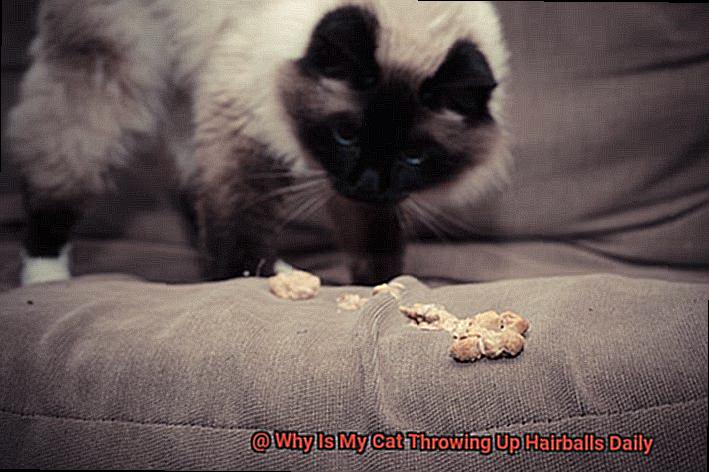
Lastly, dehydration can also lead to hairball vomiting. When cats are dehydrated, their digestive tract becomes dry and sticky, making it easier for hairballs to form. Ensure that your cat drinks enough water throughout the day to prevent dehydration and promote healthy digestion.
Dietary causes play a significant role in hairball vomiting in cats.
Feeding your feline friend a well-balanced and nutritious diet while avoiding fatty foods and ensuring they stay hydrated can help reduce the formation of hairballs and prevent daily vomiting.
Remember, if you notice excessive hairball vomiting, seek veterinary attention immediately.
Psychological Causes of Hairball Vomiting
While food choices are important, it’s also essential to consider psychological factors such as stress, anxiety, and boredom.
Cats are meticulous groomers, but excessive grooming due to psychological factors can lead to the ingestion of excessive amounts of fur, causing hairball vomiting. Stress and anxiety are common triggers of excessive grooming in cats. Changes in their environment or routine, such as moving to a new house or the introduction of a new pet or family member, can cause stress and anxiety in cats. As a result, they may resort to grooming as a means of coping with these changes.
Similarly, indoor cats who don’t have enough stimulation or playtime may become bored and turn to excessive grooming. Providing adequate playtime and environmental enrichment can reduce boredom and stress in cats, thus decreasing the risk of hairball formation.
It’s crucial for cat owners to identify these psychological factors and take steps to address them. By creating a calm and predictable routine, you can help alleviate anxiety in your feline friend. In some cases, behavioral modification techniques or medication may be necessary to address underlying anxiety or stress issues. It is imperative to consult with a veterinarian or feline behaviorist before implementing any behavioral changes or medication.
Breed-Specific Causes of Hairball Vomiting
Well, wonder no more. My extensive research has uncovered some fascinating breed-specific factors that contribute to this issue.
Firstly, long-haired breeds such as Persians and Maine Coons are more prone to hairballs due to their thicker and longer fur. These cats require more frequent grooming to prevent excessive fur ingestion, which can lead to hairball vomiting. On the other hand, short-haired breeds such as Siamese and Burmese may not experience hairballs as frequently, but this doesn’t mean they are entirely immune.
Another interesting factor is the shape of a cat’s face. Brachycephalic breeds like Persians and Himalayans have flatter faces with shorter nasal passages, making it more challenging for them to expel hairballs through coughing or gagging. Consequently, these cats may experience more frequent vomiting episodes.
Moreover, some breeds may have a predisposition to gastrointestinal issues that can lead to hairball vomiting. For instance, the Siamese breed has been known to develop inflammatory bowel disease (IBD), which can cause chronic vomiting and gastrointestinal upset. Unfortunately, this increases the likelihood of hairballs being regurgitated.
Nevertheless, it’s essential to understand that any cat can experience hairball vomiting, regardless of breed. A balanced diet, regular grooming, and veterinary check-ups can help prevent or manage hairball vomiting in all cats.
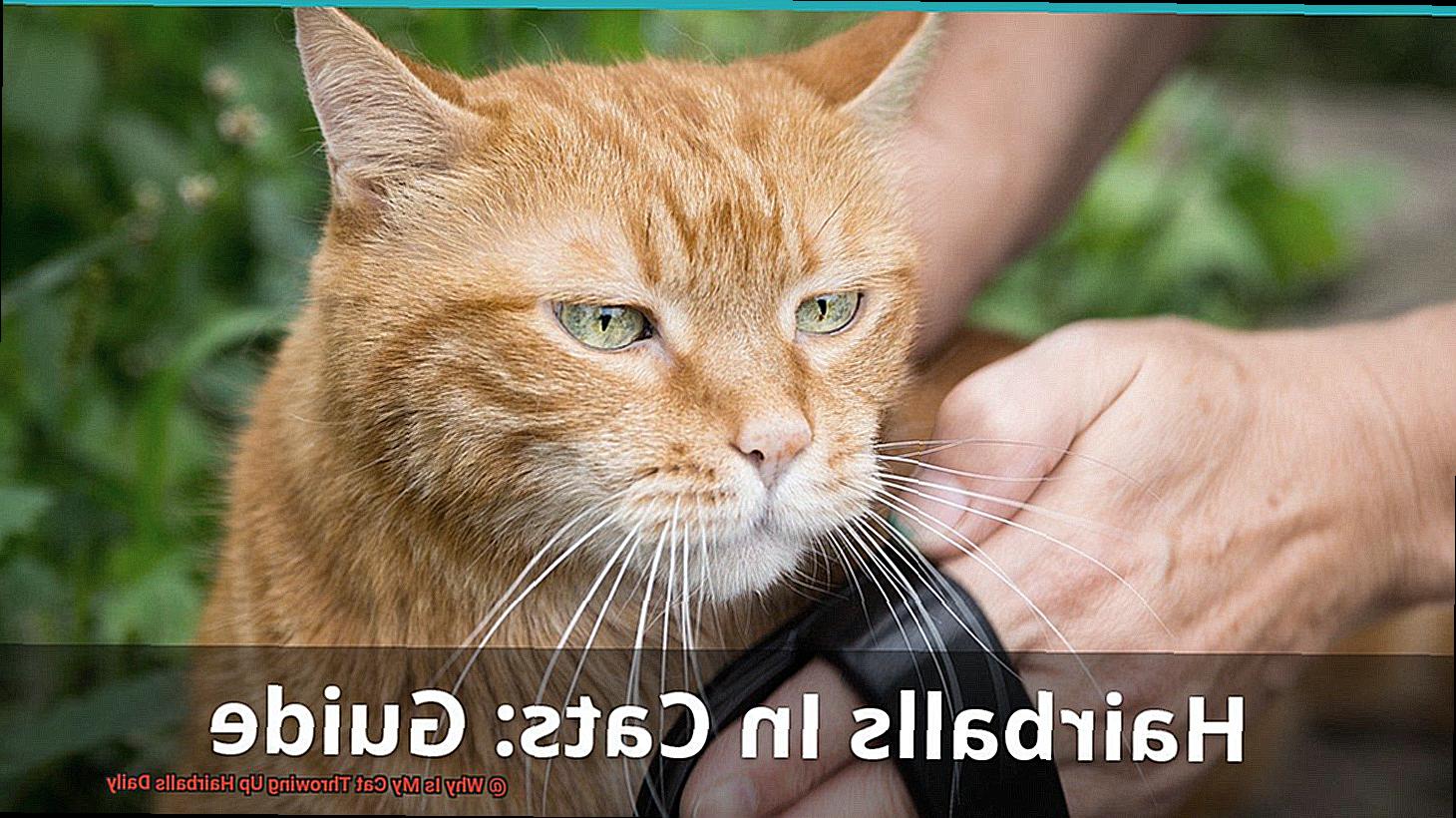
Symptoms to Look Out For
Here are the symptoms to look out for:
Firstly, keep track of your cat’s vomiting habits. While occasional hairballs are normal, frequent vomiting is not. If your cat is throwing up hairballs daily or several times a week, it’s time to take notice. It could be an indication that something else is going on.
Secondly, pay attention to your cat’s appetite. If your furry friend suddenly loses interest in food, it could mean that hairballs are causing discomfort in their digestive system. This can lead to a loss of appetite, so keep an eye out for any changes.
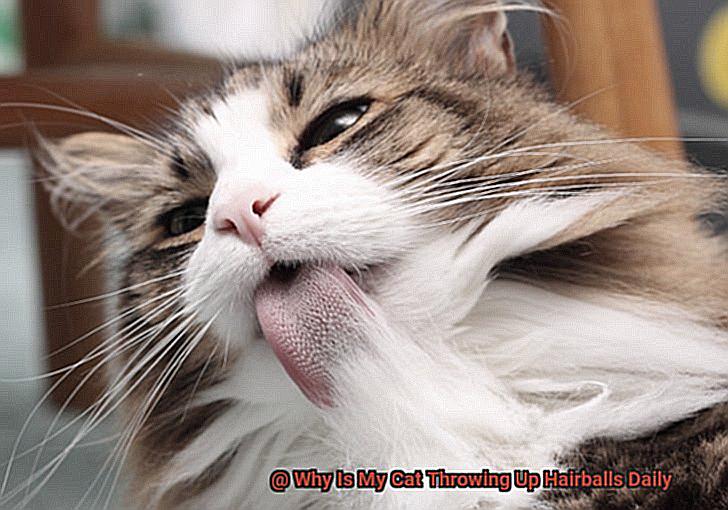
Thirdly, lethargy can be a sign that something is wrong. Cats who feel unwell may become uninterested in playing or interacting with you. If you notice this change in behavior, it’s time to investigate further.
Lastly, while vomiting is the most common symptom associated with hairballs, diarrhea can also occur in some cats. If you notice loose stools or diarrhea alongside hairball-related symptoms, it’s essential to speak with your veterinarian.
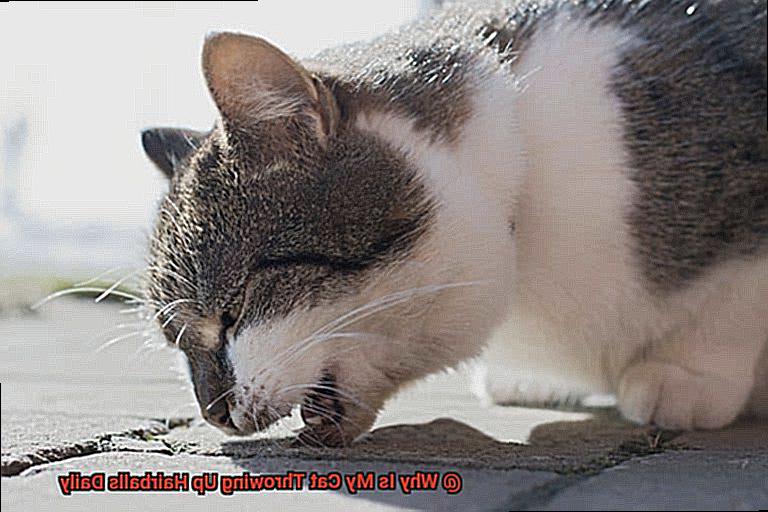
Remember, keeping an eye on your cat’s behavior and symptoms can help you catch potential issues early on. If you notice any concerning symptoms, don’t hesitate to consult with your veterinarian for further guidance and treatment options.
Treatments for Excessive Hairball Vomiting
However, excessive hairball vomiting can be a serious issue that requires proper treatment. But worry not, as there are several effective treatments available to help reduce hairball vomiting in cats.
One of the most popular treatments is specialized food that contains fiber. This fiber helps remove hair from the cat’s digestive system, preventing hairballs from forming in the first place. By incorporating this food into your cat’s diet, you can significantly reduce the frequency of hairball vomiting.
Another effective option for treating hairball vomiting in cats is hairball remedies. These tasty gels or pastes are administered orally and work by lubricating the digestive system, making it easier for hairballs to pass through. Your cat will love the taste and you’ll love the results.
Regular grooming is another way to prevent excessive hairball vomiting in cats. By brushing your cat’s fur daily, you can help remove loose hairs, reducing the amount of hair your cat ingests while grooming themselves.
In severe cases, medication may be necessary to help your cat pass hairballs more easily. Your veterinarian can prescribe medication that either breaks down hairballs or stimulates the digestive system to pass them through. With proper care and management, excessive hairball vomiting in cats can be controlled and prevented.
How to Prevent Future Hairballs
Luckily, there are several steps you can take to prevent them from forming in the first place. Let’s take a closer look at these preventative measures.
Grooming
Regular grooming sessions are crucial in maintaining your cat’s coat and preventing hairballs. Brushing or combing your cat’s fur will remove loose hair, which reduces the amount of hair they ingest while grooming themselves. It also prevents matting and tangling of their fur, making it easier for them to groom themselves.
Hydration
Adequate hydration is essential for healthy digestion, which helps prevent hairballs from forming. Ensure your cat has access to clean drinking water at all times. You may also want to consider adding wet food to their diet to increase their water intake.
Diet
Feeding your cat a high-quality diet that is rich in fiber can promote healthy digestion and reduce the incidence of hairballs. Look for foods that contain ingredients like pumpkin or psyllium husk, which can help move hair through the digestive system.
Hairball Remedy
There are several hairball remedies available on the market that can break down hair in your cat’s digestive system, making it easier for them to pass hairballs. Consult with your veterinarian to choose the best one for your cat.
Playtime
Regular playtime with your cat can help reduce stress levels, which can contribute to excessive grooming and the development of hairballs. Providing toys, scratching posts, and other forms of enrichment can also keep your cat mentally stimulated and happy, leading to an overall healthier lifestyle.

By following these preventative measures, you can significantly reduce the chances of your cat developing hairballs in the future. However, if you notice any signs of discomfort or vomiting, it is essential to seek veterinary attention immediately.
QbAB_4mXhyc” >
When to See a Vet
However, it’s crucial to know when to seek veterinary care if your cat is dealing with excessive hairball episodes. So, when exactly should you schedule that vet appointment?
First and foremost, if your cat is unable to expel the hairball after multiple attempts, it’s time to seek veterinary attention. Your cat may be repeatedly retching without producing a hairball, which could indicate that the hairball is stuck in their digestive tract, leading to a dangerous blockage. This requires immediate veterinary care to avoid life-threatening consequences.
Besides being unable to expel the hairball, if your cat is showing other worrisome symptoms such as lethargy, loss of appetite, or diarrhea, it’s best to consult with your vet. These symptoms could suggest an underlying health issue that needs to be addressed promptly.
Another critical factor to consider is the frequency of hairball vomiting. While occasional hairballs are normal, throwing up hairballs daily or multiple times a day could be a sign of an underlying health problem. Therefore, it’s crucial to monitor your cat’s vomiting habits and seek veterinary care if necessary.
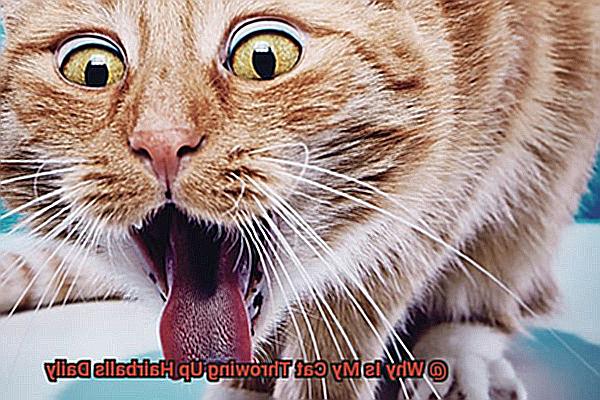
Also Read: Do Cats Puke For Attention?
Conclusion
To sum it up, hairballs are a natural occurrence in cats, but daily vomiting of hairballs can be a red flag for underlying medical issues. As a responsible cat parent, it’s crucial to be aware of the causes and symptoms of hairballs to prevent any potential health concerns for your furry friend.
The reasons behind frequent hairball vomiting in cats can range from grooming habits to medical conditions. Excessive grooming, lack of fiber in their diet, dehydration, stress or anxiety can all contribute to hairball formation and vomiting. Therefore, providing your cat with proper nutrition, regular grooming sessions, clean water supply and reducing stressors can help prevent excessive hairball formation.
Moreover, certain breeds with long fur are more prone to hairballs than others. If you notice any signs such as frequent vomiting, loss of appetite or diarrhea in your cat, don’t hesitate to take them to the vet.
To avoid dealing with daily hairball clean-up, taking preventative measures such as regular grooming sessions and providing adequate hydration through wet food diets rich in fiber is essential. Playtime with your feline friend can also help reduce stress levels that contribute to excessive grooming.
In cases where medication is necessary, always seek professional advice from your veterinarian before starting any treatment options.







